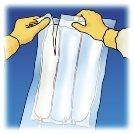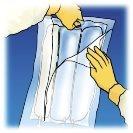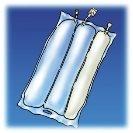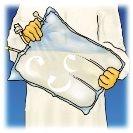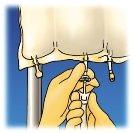
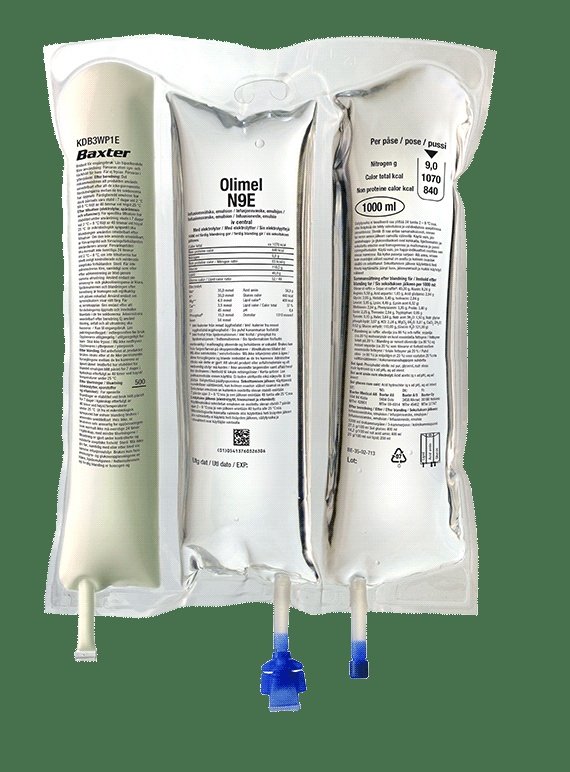
ОЛІМЕЛ N9E ЕМУЛЬСІЯ ДЛЯ ПЕРФУЗІЇ

Запитайте лікаря про рецепт на ОЛІМЕЛ N9E ЕМУЛЬСІЯ ДЛЯ ПЕРФУЗІЇ

Інструкція із застосування ОЛІМЕЛ N9E ЕМУЛЬСІЯ ДЛЯ ПЕРФУЗІЇ
Введення
Опис: інформація для користувача
Olimel N9E емульсія для перфузії
Прочитайте уважно весь опис перед тим, як вам буде введено це лікарське засоби, оскільки він містить важливу інформацію для вас.
- Збережіть цей опис, оскільки вам може знадобитися знову його прочитати.
- Якщо у вас виникли питання, проконсультуйтеся з вашим лікарем або медсестрою.
- Якщо ви відчуваєте побічні ефекти, проконсультуйтеся з вашим лікарем або медсестрою, навіть якщо це побічні ефекти, які не вказані в цьому описі. Див. розділ 4.
Зміст опису
- Що таке Olimel N9E і для чого він використовується
- Що вам потрібно знати перед тим, як вам буде введено Olimel N9E
- Як вам буде введено Olimel N9E
- Можливі побічні ефекти
- Збереження Olimel N9E
- Зміст упаковки та додаткова інформація
1. Що таке OLIMEL N9E і для чого він використовується
Olimel - це емульсія для перфузії. Він поставляється в мішці з 3 відділеннями
Одне відділення містить розчин глюкози з кальцієм, друге - емульсію ліпідів, а третє - розчин амінокислот з іншими електролітами.
Olimel використовується для харчування дорослих і дітей старше двох років через трубку в вену, коли звичайне харчування через рот неможливе
Olimel повинен використовуватися тільки під медичним наглядом.
2. Що вам потрібно знати перед тим, як вам буде введено Olimel N9E
OlimelN9Eне повинен вводитися:
- У недоношених новонароджених, немовлят і дітей молодше двох років
- Якщо ви гіперчутливі (алергічні) до білків яєць, сої, арахісу, кукурудзи/продуктів кукурудзи (див. також розділ "Попередження та обережність" нижче) або до одного з інших компонентів цього лікарського засобу (перелічених у розділі 6).
- Якщо ваш організм має проблеми з використанням певних амінокислот.
- Якщо у вас особливо високий рівень жиру в крові
- Якщо у вас гіперглікемія (зbyt багато цукру в крові)
- Якщо у вас аномально висока кількість якогось електроліту (натрію, калію, магнію, кальцію і/або фосфору) в крові.
У всіх випадках ваш лікар вирішить, чи повинен вам бути введений цей лікарський засіб, виходячи з таких факторів, як ваш вік, вага та клінічний стан, а також результати всіх проведених досліджень.
Попередження та обережність
Проконсультуйтеся з вашим лікарем або медсестрою перед тим, як вам буде введено Olimel.
Зbyt швидке введення рішень для батьківської харчування може викликати ушкодження або смерть.
Перфузія повинна бути зупинена негайно, якщо розвивається будь-який аномальний знак або симптоми алергічної реакції (як потіння, гарячка, озноб, головний біль, висипання на шкірі або труднощі з диханням). Цей лікарський засіб містить олію сої та фосфоліпіди яєць. Білки сої та яєць можуть викликати реакції гіперчутливості. Було спостережено алергічні реакції між білками сої та арахісу.
Olimel містить глюкозу, отриману з кукурудзи, яка може викликати реакції гіперчутливості, якщо у вас є алергія на кукурудзу або продукти кукурудзи (див. розділ "Olimel N9E не повинен вводитися" вище).
Труднощі з диханням також можуть бути ознакою того, що в легенях утворилися дрібні частинки, які блокують кровоносні судини (пульмональні вазкулярні осади). Якщо ви відчуваєте будь-які труднощі з диханням, повідомте про це вашому лікареві або медсестрі. Вони вирішать, які заходи потрібно вжити.
Антибіотик, званий цефтріаксоном, не повинен змішуватися або вводитися одночасно з рішеннями, які містять кальцій (включаючи Olimel), введеними через вену.
Ці лікарські засоби не повинні вводитися разом, навіть через різні лінії або місця перфузії.
Однак Olimel і цефтріаксон можуть вводитися послідовно один за одним, якщо використовуються лінії перфузії в різних точках, або якщо лінії перфузії заміняються або ретельно промиваються фізіологічним розчином між перфузіями, щоб уникнути утворення осадів (утворення частинок цефтріаксону та солі кальцію).
Деякі лікарські засоби та захворювання можуть збільшити ризик розвитку інфекцій або сепсису (бактерій в крові). Існує ризик інфекції або сепсису, особливо коли встановлюється трубка (центральний венозний катетер) у вену. Лікар буде ретельно спостерігати за вами за ознаками інфекції.
Пацієнти, які потребують батьківської харчування (введення харчових речовин через трубку, введену в вену), можуть мати більшу схильність до інфекцій через свій медичний стан. Використання "асептичних технік" (без мікробів) при встановленні та обслуговуванні катетера та при підготовці харчової формули (НПТ) може зменшити ризик інфекції.
Якщо ви сильно недохранені та потребуєте отримання харчування через вену, ваш лікар повинен розпочати лікування повільно. Крім того, вас буде контролювати, щоб уникнути раптових змін у рівнях рідини, вітамінів, електролітів та мінералів.
Перед початком перфузії повинні бути виправлені метаболічні розлади та водно-сольовий баланс вашого організму. Ваш лікар буде спостерігати за вашим станом під час введення цього лікарського засобу та може змінити дозу або додати інші харчові речовини, такі як вітаміни, електроліти та олігоелементи, якщо це буде вважати за необхідне.
Було повідомлено про випадки порушення функції печінки, включаючи проблеми з виведенням жовчі (холестаз), накопичення жиру (стеатоз печінки), фіброз, який може спричинити недостатність печінки, а також холецистит та холелітіаз у пацієнтів, які отримують батьківське харчування. Говорять, що причиною цих порушень є множинні фактори та може відрізнятися між пацієнтами. Якщо ви відчуваєте симптоми, такі як нудота, блювота, біль у животі, жовтяниця шкіри чи очей, повідомте про це вашому лікареві, щоб він міг визначити можливі причини та заходи щодо лікування та профілактики.
Ваш лікар повинен знати, якщо у вас:
- є деякі серйозні проблеми з нирками. Ви також повинні повідомити своєму лікареві, якщо ви отримуєте лікування діалізом (штучна нирка) або якщо у вас є інший тип лікування для очищення крові
- є деякі серйозні проблеми з печінкою
- є деякі проблеми з згортанням крові
- є порушення функції наднирників (недостатність наднирників). Наднирники мають трикутну форму та розташовані над нирками
- є недостатність серця
- є захворювання легенів
- є надмірна кількість води в організмі (гіпергідратация)
- є недостатня кількість води в організмі (дегідратация)
- є надмірна кількість цукру в крові (цукровий діабет) без лікування
- є інфаркт міокарда або шок через раптову недостатність серця
- є тяжка метаболічна ацидоз (зbyt кисла кров)
- є загальна інфекція (сепсис)
- є кома
Для перевірки ефективності та безпеки введення ваш лікар буде проводити лабораторні та клінічні дослідження під час введення цього лікарського засобу. Якщо вам буде введено цей лікарський засіб протягом декількох тижнів, ваша кров буде регулярно аналізуватися.
Зниження здатності організму виводити жири, які містить цей лікарський засіб, може призвести до "синдрому перевантаження жирами" (див. розділ 4 "Можливі побічні ефекти").
Якщо під час перфузії ви відчуваєте біль, печіння або набряк в місці перфузії або витік перфузії, повідомте про це вашому лікареві або медсестрі. Перфузія буде негайно зупинена та відновлена в іншій вені.
Якщо ваш рівень цукру в крові знизиться зbyt сильно, лікар повинен буде регулювати швидкість введення Olimel або вводити лікарські засоби для контролю рівня цукру в крові (інсулін).
Olimel може вводитися тільки через трубку (катетер), підключену до великої вени в вашому грудному відділі (центральна вена).
Діти та підлітки
Якщо ваш дитина молодше 18 років, буде приділено особливу увагу введенню правильної дози. Також повинні бути вжиті додаткові заходи через більшу чутливість дітей до ризику інфекції. Додавання вітамінів та олігоелементів завжди необхідне. Повинні використовуватися педіатричні формули.
ВикористанняOlimelз іншими лікарськими засобами
Повідомте своєму лікареві, якщо ви приймаєте або використовуєте, приймали або використовували нещодавно або можете приймати чи використовувати будь-які інші лікарські засоби.
Одночасне прийняття інших лікарських засобів зазвичай не є протипоказанням. Якщо ви приймаєте інші лікарські засоби, отримані за рецептом або без нього, ви повинні проконсультуватися з вашим лікарем заздалегідь, щоб він міг перевірити їх сумісність.
Повідомте своєму лікареві, якщо ви приймаєте або отримуєте будь-які з наступних лікарських засобів:
- інсулін
- гепарин
Olimel не повинен вводитися одночасно з кров'ю через одну й ту саму перфузійну лінію.
Olimel містить кальцій. Не повинен вводитися разом або через одну й ту саму перфузійну лінію з антибіотиком цефтріаксоном, оскільки можуть утворюватися частинки. Якщо використовується той самий пристрій для введення цих лікарських засобів послідовно, його потрібно ретельно промити
Через ризик осадження Olimel не повинен вводитися через одну й ту саму перфузійну лінію чи змішуватися з антибіотиком амоксициліном чи протиепілептичним засобом фосфенітоїном.
Олії оливкової та соєвої, присутні в Olimel, містять вітамін К. Це зазвичай не впливає на лікарські засоби для розрідження крові (антICOагулянти), такі як кумарин. Однак, якщо ви приймаєте антICOагулянти, ви повинні повідомити про це своєму лікареві.
Ліпіди, які містить ця емульсія, можуть вплинути на результати деяких лабораторних досліджень, якщо зразок крові береться до того, як вони будуть виведені з вашого кровотоку (зазвичай це відбувається через 5-6 годин без прийняття ліпідів).
Olimel містить калій. Повинна бути вжита особлива обережність у пацієнтів, які приймають діуретики, інгібітори АПФ, антагоністи рецептора II ангіотензину (лікарські засоби проти гіпертонії) або імунодепресанти. Ці класи лікарських засобів можуть збільшити рівень калію в крові.
Вагітність та лактація
Якщо ви вагітні або перебуваєте у період лактації, вважаєте, що можете бути вагітною або плануєте завагітніти, проконсультуйтеся з вашим лікарем перед тим, як вам буде введено цей лікарський засіб.
Немає достатнього досвіду використання Olimel у вагітних жінок або у період лактації. Olimel може використовуватися під час вагітності та лактації, якщо це необхідно. Olimel повинен вводитися вагітним жінкам або у період лактації тільки після ретельного розгляду.
Водіння транспортних засобів та використання машин
Не застосовується.
3. Як вам буде введено Olimel N9E
Доза
Olimel повинен вводитися тільки дорослим і дітям старше двох років.
Це емульсія для перфузії, тобто для введення через трубку (катетер) у велику вену вашого грудного відділу.
Olimel повинен бути при кімнатній температурі перед його використанням.
Olimel призначений для одного використання.
Доза - дорослі
Ваш лікар визначить швидкість перфузії залежно від ваших потреб та клінічного стану.
Введення може тривати так довго, як це необхідно, залежно від вашого клінічного стану.
Доза - діти старше двох років та підлітки
Лікар вирішить дозу та тривалість введення лікарського засобу залежно від віку, ваги, зросту, клінічного стану та здатності організму розщеплювати та використовувати інгредієнти ОЛІМЕЛ.
Якщо вам було введено зазbyt багато Olimel N9E
Якщо доза, введена вам, зbyt висока або перфузія зbyt швидка, вміст амінокислот може зробити вашу кров зbyt кислотною, та можуть виникнути ознаки гіперволемії (збільшення об'єму циркулюючої крові). Рівень глюкози в вашій крові та сечі може збільшитися, може розвинутися гіперосмолярний синдром, та вміст ліпідів може збільшити рівень тригліцеридів у вашій крові. Введення зазbyt швидкої або зазbyt великої кількості Olimel може викликати у вас нудоту, блювоту, озноб, головний біль, гарячку, потіння, надмірне потіння (гіпергідроз) та порушення електролітного балансу. У цьому випадку перфузія повинна бути негайно зупинена.
У деяких випадках лікар може бути змушений тимчасово провести діаліз нирок, щоб допомогти вашим ниркам вивести зазbyt багато лікарського засобу.
Для уникнення таких випадків ваш лікар буде регулярно спостерігати за вашим станом та аналізувати ваші показники крові.
Якщо у вас є будь-які інші питання щодо використання цього лікарського засобу, проконсультуйтеся з вашим лікарем.
У разі передозування або випадкового прийняття лікарського засобу зверніться до служби токсикологічної інформації. Телефон 915.620.420
4. Можливі побічні ефекти
Як і всі лікарські засоби, цей лікарський засіб може викликати побічні ефекти, хоча не всі люди їх відчувають. Якщо ви відчуваєте, що не відчуваєте себе добре, негайно повідомте про це своєму лікареві або медсестрі.
Дослідження, які ваш лікар буде проводити під час прийняття цього лікарського засобу, повинні мінімізувати ризик побічних ефектів.
Якщо розвивається будь-який аномальний знак або симптоми алергічної реакції, такі як потіння, гарячка, озноб, головний біль, висипання на шкірі або труднощі з диханням, перфузія повинна бути негайно зупинена.
Було описано наступні побічні ефекти при застосуванні Olimel:
Частота - часто: може впливати до 1 з 10 людей
- Швидке серцебиття (тахікардія).
- Зниження апетиту.
- Збільшення рівня жиру в крові (гіпертригліцеридемія).
- Біль у животі.
- Діарея.
- Нудота.
- Високий кров'яний тиск (гіпертонія).
Частота - невідома: не може бути оцінена з наявних даних
- Алергічні реакції, які включають потіння, гарячку, озноб, головний біль, висипання на шкірі, свербіж, гарячку, труднощі з диханням
- Витік перфузії в навколишні тканини (екстравазація) може викликати біль у місці перфузії, подразнення, набряк/едем, червоність (еритема)/гарячку, загибель клітин тканини (некроз шкіри) або пухирі/везикули, запалення, загустіння або звуження шкіри.
- Блювота.
Було описано наступні побічні ефекти при застосуванні інших подібних лікарських засобів для батьківського харчування:
Частота - зрідка: можуть впливати до 1 з 10000 людей
- Зниження здатності виводити ліпіди (синдром перевантаження жирами) у поєднанні з раптовим погіршенням стану пацієнта. Наступні симптоми синдрому перевантаження жирами зазвичай є оборотними, коли перфузія ліпідної емульсії зупиняється:
- Гарячка.
- Зниження рівня червоних кров'яних тілець, яке може зробити вашу шкіру блідою та викликати слабкість або труднощі з диханням (анемія).
- Низький рівень лейкоцитів, який може збільшити ризик інфекції (лейкопенія).
- Низький рівень тромбоцитів, який може збільшити ризик синяків та/або кровотечі (тромбоцитопенія).
- Порушення згортання крові, які впливають на здатність крові згортатися
- Високий рівень жиру в крові (гіперліпідемія).
- Жирове фільтрування в печінці (гепатомегалія).
- Погіршення функції печінки.
- Маніфестації з боку центральної нервової системи (напр., кома).
Частота - невідома: не може бути оцінена з наявних даних
- Алергічні реакції.
- Порушення виведення жовчі (холестаз).
- Аномальні показники крові для функції печінки.
- Збільшення розміру печінки (гепатомегалія).
- Хвороби, пов'язані з батьківським харчуванням (див. "Попередження та обережність" у розділі 2).
- Жовтяниця.
- Зниження рівня тромбоцитів (тромбоцитопенія).
- Збільшення рівня нітрогену в крові (азотемія).
- Збільшення рівня ферментів печінки.
- Утворення дрібних частинок, які можуть призвести до блокування кровоносних судин в легенях (пульмональні вазкулярні осади), що може призвести до емболії легенів та труднощів з диханням (труднощі з диханням).
Повідомлення про побічні ефекти:
Якщо ви відчуваєте будь-який побічний ефект, проконсультуйтеся з вашим лікарем або медсестрою, навіть якщо це можливі побічні ефекти, які не вказані в цьому описі. Ви також можете повідомити про них безпосередньо через систему моніторингу лікарських засобів: https://www.notificaram.es. Повідомляючи про побічні ефекти, ви можете допомогти надати більше інформації про безпеку цього лікарського засобу.
5. Збереження Olimel N9E
Тримайте цей лікарський засіб поза досяжністю дітей.
Не використовуйте цей лікарський засіб після закінчення терміну придатності, вказаного на упаковці та зовнішній упаковці (ММ/РРРР). Термін придатності - останній день місяця, вказаного на упаковці.
Не заморожуйте.
Тримайте в зовнішній упаковці.
Лікарські засоби не повинні викидатися в каналізацію чи сміття. Спитайте в вашого фармацевта, як позбутися упаковок та лікарських засобів, які вам не потрібні. Таким чином ви допоможете захистити навколишнє середовище.
6. Зміст упаковки та додаткова інформація
Склад ОлімелуN9E
Активні речовини кожної сумки реконституїрованої емульсії - це розчин L-амінокислот 14,2% (що відповідає 14,2 г/100 мл аланіну, аргініну, гліцину, гістидину, ізолейцину, лейцину, лізину (у вигляді ацетату лізину), метіоніну, фенілаланіну, проліну, серину, треоніну, триптофану, тирозину, валину, аспарагінової кислоти, глутамінової кислоти) з електролітами (натрієм, калієм, магнієм, фосфатом, ацетатом, хлоридом), емульсією ліпідів 20% (що відповідає 20 г/100 мл рафінованої оливкової олії та рафінованої соєвої олії) і розчином глюкози 27,5% (що відповідає 27,5 г/100 мл у вигляді глюкози моногідрату) з кальцієм.
Інші компоненти:
Відділ ліпідної емульсії | Відділ розчину амінокислот | Відділ розчину глюкози |
Фосфоліпіди очищеного яйця, гліцерол, олеат натрію, гідроксид натрію (для регулювання pH), вода для ін'єкційних препаратів | Оцтова кислота (для регулювання pH), вода для ін'єкційних препаратів | Хлоридна кислота (для регулювання pH), вода для ін'єкційних препаратів |
Вигляд Олімелу N9Eта вміст упаковки
Олімел - це емульсія для перфузії, упакована в сумку з 3 відділами. Один відділ містить ліпідну емульсію, інший - розчин амінокислот з електролітами, а третій - розчин глюкози з кальцієм. Ці відділи розділені непостійними загородками. Перед введенням вміст відділів потрібно перемішати, обертаючи сумку навколо себе з верху сумки до тих пір, поки загородки не відкриються.
Вигляд до реконституції:
- Розчини амінокислот і глюкози прозорі, безколірні або легенько жовтуваті.
- Ліпідна емульсія однорідна і має молочний колір.
Вигляд після реконституції: Однорідна молочна емульсія.
Трикамерна сумка виготовлена з пластику з кількома шарами. Матеріал внутрішнього шару сумки (контакт) розроблений для сумісності з компонентами та дозволеними добавками.
Для уникнення контакту з повітряним киснем сумка упакована в зовнішню сумку, яка діє як бар'єр проти кисню, і містить пакет з абсорбентом кисню.
Варіанти упаковки
Сумка об'ємом 1000 мл: 1 картонна коробка з 6 сумками
Сумка об'ємом 1500 мл: 1 картонна коробка з 4 сумками
Сумка об'ємом 2000 мл: 1 картонна коробка з 4 сумками
1 сумка об'ємом 1000 мл, 1500 мл і 2000 мл
Можливо, що тільки деякі варіанти упаковки будуть продаватися.
Власник дозволу на розміщення продукції на ринку
Baxter S.L.
Pouet de Camilo 2, 46394 Ribarroja del Turia (Валенсія)
Виробник
Baxter S.A., Boulevard René Branquart, 80, 7860 Lessines, Бельгія
Цей лікарський засіб дозволений в державах-членах Європейського економічного простору під наступними назвами:
Франція, Португалія, Естонія, Польща, Литва, Болгарія, Румунія, Латвія, Чехія, Бельгія, Іспанія, Словаччина, Нідерланди, Люксембург, Словенія, Італія, Греція, Кіпр: ОЛІМЕЛ N9E
У деяких країнах зареєстрований під іншими назвами, як описано нижче:
Австрія: ZentroOLIMEL 5,7% з електролітами
Німеччина: Olimel 5,7% Е
Данія, Ісландія, Швеція, Норвегія, Фінляндія: Olimel N9E
Велика Британія, Ірландія та Мальта: Triomel 9г/л азоту 1070 ккал/л з електролітами
Угорщина: Olimel 9 г/л азоту з електролітами емульсійна інфузія
Дата останнього перегляду цієї інструкціїквітень 2020
Детальна та актуальна інформація про цей лікарський засіб доступна на сайті Агентства лікарських засобів та медичних продуктів Іспанії (AEMPS) http://www.aemps.gob.es/
Ця інформація призначена лише для медичних працівників
Фармакотерапевтична група: розчини для парентерального харчування / комбінації
Код ATC: B05 BA10.
- Якість і кількість складу
Олімел випускається у вигляді сумки з 3 відділами. Кожна сумка містить розчин глюкози з кальцієм, ліпідну емульсію та розчин амінокислот з іншими електролітами.
Вміст на сумку | |||
1000 мл | 1500 мл | 2000 мл | |
Розчин глюкози 27,5% (що відповідає 27,5 г/100 мл) | 400 мл | 600 мл | 800 мл |
Розчин амінокислот 14,2% (що відповідає 14,2 г/100 мл) | 400 мл | 600 мл | 800 мл |
Ліпідна емульсія 20% (що відповідає 20 г/100 мл) | 200 мл | 300 мл | 400 мл |
Після перемішування вмісту 3 відділів склад реконституїрованої емульсії вказано в наступній таблиці для кожного розміру сумки.
Активні речовини | 1000 мл | 1500 мл | 2000 мл |
Оливкова олія + соєва олія Аланін Аргінін Аспарагінова кислота Глутамінова кислота Гліцин Гістидин Ізолейцин Лейцин Лізин (еквівалентно лізину ацетату) Метіонін Фенілаланін Пролін Серин Треонін Триптофан Тирозин Валін Ацетат натрію тригідрат Гліцерофосфат натрію гідрат Хлорид калію Хлорид магнію гексагідрат Хлорид кальцію дигідрат Глюкоза (еквівалентно глюкози моногідрату) | 40,00 г 8,24 г 5,58 г 1,65 г 2,84 г 3,95 г 3,40 г 2,84 г 3,95 г 4,48 г (6,32 г) 2,84 г 3,95 г 3,40 г 2,25 г 2,84 г 0,95 г 0,15 г 3,64 г 1,50 г 3,67 г 2,24 г 0,81 г 0,52 г 110,00 г (121,00 г) | 60,00 г 12,36 г 8,37 г 2,47 г 4,27 г 5,92 г 5,09 г 4,27 г 5,92 г 6,72 г (9,48 г) 4,27 г 5,92 г 5,09 г 3,37 г 4,27 г 1,42 г 0,22 г 5,47 г 2,24 г 5,51 г 3,35 г 1,22 г 0,77 г 165,00 г (181,50 г) | 80,00 г 16,48 г 11,16 г 3,30 г 5,69 г 7,90 г 6,79 г 5,69 г 7,90 г 8,96 г (12,64 г) 5,69 г 7,90 г 6,79 г 4,50 г 5,69 г 1,90 г 0,30 г 7,29 г 2,99 г 7,34 г 4,47 г 1,62 г 1,03 г 220,00 г (242,00 г) |
(а) Включає калорії фосфоліпідів очищеного яйця
Допоміжні речовини:
Відділ ліпідної емульсії | Відділ розчину амінокислот з електролітами | Відділ розчину глюкози з кальцієм |
Фосфоліпіди очищеного яйця, гліцерол, олеат натрію, гідроксид натрію (для регулювання pH), вода для ін'єкційних препаратів | Оцтова кислота (для регулювання pH), вода для ін'єкційних препаратів | Хлоридна кислота (для регулювання pH), вода для ін'єкційних препаратів |
Реконституїована емульсія забезпечує наступне для кожного розміру сумки:
1000 мл | 1500 мл | 2000 мл | |
Ліпіди | 40 г | 60 г | 80 г |
Амінокислоти | 56,9 г | 85,4 г | 113,9 г |
Азот | 9,0 г | 13,5 г | 18,0 г |
Глюкоза | 110,0 г | 165,0 г | 220,0 г |
Енергія: | |||
Приблизно загальна калорійність | 1070 ккал | 1600 ккал | 2140 ккал |
Непротеїнові калорії | 840 ккал | 1260 ккал | 1680 ккал |
Калорії глюкози | 440 ккал | 660 ккал | 880 ккал |
Калорії ліпідів (а) | 400 ккал | 600 ккал | 800 ккал |
Відношення непротеїнових калорій до азоту | 93 ккал/г | 93 ккал/г | 93 ккал/г |
Відношення калорій глюкози до ліпідів | 52/48 | 52/48 | 52/48 |
Калорії ліпідів / загальна калорійність | 37% | 37% | 37% |
Електроліти: | |||
Натрій | 35,0 ммоль | 52,5 ммоль | 70,0 ммоль |
Калій | 30,0 ммоль | 45,0 ммоль | 60,0 ммоль |
Магній | 4,0 ммоль | 6,0 ммоль | 8,0 ммоль |
Кальцій | 3,5 ммоль | 5,3 ммоль | 7,0 ммоль |
Фосфат (б) | 15,0 ммоль | 22,5 ммоль | 30,0 ммоль |
Ацетат | 54 ммоль | 80 ммоль | 107 ммоль |
Хлорид | 45 ммоль | 68 ммоль | 90 ммоль |
pH | 6,4 | 6,4 | 6,4 |
Осмолярність | 1310 мОсм/л | 1310 мОсм/л | 1310 мОсм/л |
а Включає калорії фосфоліпідів очищеного яйця
б Включає фосфат, забезпечений ліпідною емульсією
- Дозування та спосіб введення
Дозування
Не рекомендується використовувати Олімел у дітей молодших 2 років, оскільки ні склад, ні об'єм не відповідають вимогам (див. розділи 4.4, 5.1 та 5.2 Інструкції).
Максимальна добова доза, вказана нижче, не повинна перевищуватися. Через незмінний склад багатокамерної сумки можливо, що одночасне задоволення потреб усіх нутрієнтів пацієнта буде неможливим. Можуть виникнути клінічні ситуації, коли пацієнту потрібні кількості нутрієнтів, що відрізняються від складу сумки. У这种 ситуації будь-яка корекція об'єму (дози) повинна враховувати результатуючий ефект на дозування інших нутрієнтів Олімелу.
У дорослих
Дозування залежить від енергетичних витрат пацієнта, його клінічного стану, маси тіла та здатності метаболізувати компоненти Олімелу, а також енергії чи білків, додатково введених перорально чи ентерально. Тому потрібно вибрати відповідний розмір сумки.
Середні добові потреби:
- Від 0,16 до 0,35 г азоту/кг маси тіла (від 1 до 2 г амінокислот/кг), залежно від стану харчування пацієнта та рівня катаболічного стресу.
- Від 20 до 40 ккал/кг.
- Від 20 до 40 мл рідини/кг, або від 1 до 1,5 мл на кожну витрачена ккал.
Для Олімелу максимальна добова доза визначається через введення амінокислот, 35 мл/кг, що відповідає 2,0 г/кг амінокислот, 3,9 г/кг глюкози, 1,4 г/кг ліпідів, 1,2 ммоль/кг натрію та 1,1 ммоль/кг калію. Для пацієнта масою 70 кг це відповідає 2450 мл Олімелу на добу, що забезпечує введення 140 г амінокислот, 270 г глюкози та 98 г ліпідів, тобто 2058 непротеїнових ккал та 2622 загальних ккал.
Зазвичай швидкість введення повинна збільшуватися поступово протягом першої години, а потім коригуватися з урахуванням введеної дози, добової потреби в об'ємі та тривалості перфузії.
Для Олімелу максимальна швидкість перфузії становить 1,8 мл/кг/год, що відповідає 0,10 г/кг/год амінокислот, 0,19 г/кг/год глюкози та 0,07 г/кг/год ліпідів.
У дітей старших 2 років та підлітків
Не проводилися дослідження на педіатричній популяції.
Дозування залежить від енергетичних витрат пацієнта, його клінічного стану, маси тіла та здатності метаболізувати компоненти Олімелу, а також енергії чи білків, додатково введених перорально чи ентерально. Тому потрібно вибрати відповідний розмір сумки.
Крім того, добові потреби в рідині, азоті та енергії поступово зменшуються з віком: виділяють дві вікові групи, одну від 2 до 11 років, а іншу - від 12 до 18 років.
Для Олімелу N9E у групі від 2 до 11 років обмежувальною є концентрація магнію для добової дози, тоді як концентрація глюкози обмежує швидкість введення на годину. У групі від 12 до 18 років обмежувальними для добової дози є концентрації амінокислот та магнію, а для швидкості введення на годину - концентрація амінокислот. Результатуючі потреби такі:
Склад | Від 2 до 11 років | Від 12 до 18 років | ||
Рекомендовано | ОЛІМЕЛ N9E Об'єм макс | Рекомендовано | ОЛІМЕЛ N9E Об'єм макс | |
Максимальна добова доза | ||||
Рідини (мл/кг/добу) | 60 – 120 | 25 | 50 – 80 | 35 |
Амінокислоти (г/кг/добу) | 1 – 2 (до 2,5) | 1,4 | 1 – 2 | 2,0 |
Глюкоза (г/кг/добу) | 1,4 – 8,6 | 2,8 | 0,7 – 5,8 | 3,9 |
Ліпіди (г/кг/добу) | 0,5 – 3 | 1,0 | 0,5 – 2 (до 3) | 1,4 |
Загальна енергія (ккал/кг/добу) | 30 – 75 | 26,8 | 20 – 55 | 37,5 |
Максимальна швидкість на годину | ||||
ОЛІМЕЛ N9E (мл/кг/год) | 3,3 | 2,1 | ||
Амінокислоти (г/кг/год) | 0,20 | 0,19 | 0,12 | 0,12 |
Глюкоза (г/кг/год) | 0,36 | 0,36 | 0,24 | 0,23 |
Ліпіди (г/кг/год) | 0,13 | 0,13 | 0,13 | 0,08 |
а: Рекомендовані значення згідно з інструкціями ESPGHAN/ESPEN/ESPR 2018
Зазвичай швидкість введення повинна збільшуватися поступово протягом першої години, а потім коригуватися з урахуванням введеної дози, добової потреби в об'ємі та тривалості перфузії.
У разі дітей молодших років рекомендується починати перфузію з зменшеної добової дози та поступово збільшувати її до максимальної дози (див. попередній пункт).
Спосіб та тривалість введення
Для одного використання.
Після відкриття сумки рекомендується використовувати її вміст негайно та не зберігати для подальших перфузій.
Вигляд суміші після реконституції - однорідна молочна емульсія.
Для отримання інструкцій щодо підготовки та обробки емульсії для перфузії див. розділ 6.6 Інструкції.
Через високу осмолярність Олімел можна вводити лише через центральну вену.
Рекомендована тривалість перфузії однієї сумки парентерального харчування становить від 12 до 24 годин.
Лікування парентеральним харчуванням може тривати так довго, як це потрібно для клінічного стану пацієнта.
- Несумісності
Не слід додавати жодного іншого лікарського засобу чи препарату до жодного з компонентів сумки чи реконституїрованої емульсії без попередньої перевірки їхньої сумісності та стабільності отриманого препарату (зокрема стабільності ліпідної емульсії).
Можуть виникнути несумісності через надмірну кислотність (низький pH) чи недостатній вміст двовалентних катів (Ca2+ та Mg2+), що можуть дестабілізувати ліпідну емульсію.
Як і з будь-якою сумішшю парентерального харчування, потрібно враховувати відношення кальцію та фосфату. Надмірне додавання кальцію та фосфату, особливо у вигляді мінеральних солей, може призвести до утворення осадів фосфату кальцію
Олімел містить іони кальцію, що підвищує ризик коагуляції крові, антикоагульованої цитратом.
Не слід змішувати чи вводити одночасно з Олімелом цефтриаксону через те ж перфузійне місце (наприклад, через конектор Y) через ризик осадження цефтриаксони з кальцієвою солі (див. розділи 4.4 та 4.5 Інструкції). Цефтриаксон та розчини, що містять кальцій, можуть вводитися послідовно один за одним, якщо використовуються перфузійні місця в різних точках, або якщо перфузійні лінії заміняються чи промиваються.
Через ризик осадження не слід вводити Олімел через те ж перфузійне місце чи змішувати з ампіциліном чи фосфенітоїном.
Перед введенням потрібно перевірити сумісність з розчинами, що вводяться одночасно через те ж обладнання, катетер чи канюлю.
Не слід вводити раніше, одночасно чи пізніше крові через те ж обладнання через ризик псевдоаглютинації.
- Особливі заходи з виведення та інші процедури
У Таблиці 1 наведено загальний огляд етапів підготовки для введення Олімелу.
Для відкриття
Видаліть захисну зовнішню сумку.
Видаліть пакет з абсорбентом кисню.
Перевірте цілісність сумки та непостійних загородок. Використовуйте її лише у разі, якщо сумка не пошкоджена, а загородки цілі (тобто не відкриті).
Не змішуйте вміст трьох відділів), якщо розчин амінокислот і розчин глюкози є прозорими, безбарвними або легенько жовтуватими, практично вільними від видимих частинок і якщо ліпідна емульсія є однорідною рідиною молочного вигляду.
Змішування розчинів і емульсії
Перевірте, чи продукт знаходиться при кімнатній температурі, коли ви розламуєте непостійні пломби.
Руку вкруг себе, починаючи з верхньої частини мішка (крайки для підвішування). Непостійні пломби зникнуть з боку, ближчого до входів. Продовжуйте скручування до тих пір, поки пломби не відкриються приблизно до половини своєї довжини.
Змішайте мішок, перевернувши його щонайменше 3 рази.
Вигляд після реконструкції - однорідна емульсія, подібна до молока.
Додатки
Мішок має достатню ємність, щоб до нього можна було додати вітаміни, електроліти та мікроелементи.
Будь-який додаток (включно з вітамінами) повинен бути здійснений у реконструйованій суміші (після відкриття непостійних пломб і змішування вмісту трьох відділів).
Також можна додати вітаміни до відділу глюкози до реконструкції суміші (до відкриття непостійних пломб і змішування вмісту трьох відділів).
Коли здійснюються додатки до формул, що містять електроліти, потрібно враховувати кількість електролітів, які вже присутні в мішку.
Додатки повинні здійснюватися кваліфікованим персоналом у стерильних умовах.
Olimel можна доповнювати електролітами згідно з наступною таблицею:
На 1000 мл | |||
Включений рівень | Додатковий максимальний рівень | Максимальний загальний рівень | |
Натрій | 35 ммоль | 115 ммоль | 150 ммоль |
Калій | 30 ммоль | 120 ммоль | 150 ммоль |
Магній | 4,0 ммоль | 1,6 ммоль | 5,6 ммоль |
Кальцій | 3,5 ммоль | 1,5 (0,0(а)) ммоль | 5,0 (3,5(а)) ммоль |
Негорганічний фосфат | 0 ммоль | 3,0 ммоль | 3,0 ммоль |
Органічний фосфат | 15 ммоль(б) | 10 ммоль | 25 ммоль(б) |
а Відповідає значення доданку негорганічного фосфату
б Включно з фосфатом, наданим ліпідною емульсією
Мікроелементи та вітаміни:
Було доведено стабільність з комерційно доступними препаратами вітамінів та мікроелементів (містять до 1 мг заліза).
Можна проконсультуватися щодо сумісності з іншими добавками за запитом.
Під час здійснення додатків потрібно виміряти остаточну осмолярність суміші перед введенням її через периферійну вену.
Для здійснення додатку:
- Воно повинно здійснюватися в стерильних умовах.
- Підготовіть місце введення мішка.
- Проколіть місце введення та введіть добавки за допомогою голки для ін'єкції або пристрою для реконструкції.
- Змішайте вміст мішка та добавки.
Підготовка до інфузії
Воно повинно здійснюватися в стерильних умовах.
Підвісьте мішок.
Видаліть пластиковий захист з місця виходу для введення.
Вставте міцно наконечник інфузійної системи в місце виходу для введення.
Таблиця1: Кроки підготовкидля введенняOlimel
1. |
| 2. |
| 3. |
|
Розламайте зверху, щоб відкрити зовнішній мішок. | Видаліть передню частину зовнішнього мішка, щоб отримати доступ до мішка Olimel. Витратьте зовнішній мішок і пакетик з оксигеном. | Помістіть мішок на горизонтальну поверхню та очистіть його, тримаючи за ручку. | |||
4. |
| 5. |
| 6. |
|
Піднімайте область для підвішування, щоб видалити рідину з верхньої частини мішка. Скручуйте міцно верхню частину мішка, доки пломби не відкриються повністю (приблизно до половини). | Змішайте вміст, перевернувши мішок щонайменше 3 рази. | Підвісьте мішок. Поверніть захист, щоб видалити його з місця виходу для введення. Міцно підключіть наконечник інфузійної системи. |
Введення
Тільки для одного використання.
Вводьте продукт лише після того, як були розламані непостійні пломби між трьома відділами та змішано вміст трьох відділів.
Перевірте, чи остаточна емульсія для інфузії не показує жодного розшарування фаз.
Після відкриття мішка його вміст потрібно використовувати негайно. Відкритий мішок ніколи не повинен зберігатися для подальшого введення. Не підключайте знову частково використаний мішок.
Не підключайте мішки послідовно, щоб уникнути утворення газової емболії внаслідок газу, що існує в першому мішку.
Всі незастосовані ліки, матеріали, що були в контакті з ними, та всі необхідні пристрої повинні бути утилізовані.
Екстравазація
Зону катетера потрібно регулярно інспектувати, щоб виявити ознаки екстравазації.
Якщо відбувається екстравазація, введення потрібно зупинити негайно, зберігаючи канюлю або катетер на місці для негайного лікування пацієнта. Якщо це можливо, потрібно здійснити аспірацію через канюлю/катетер, щоб зменшити кількість рідини, присутньої в тканинах, перед видаленням канюлі/катетера.
Необхідно вжити конкретні заходи залежно від стадії або ступеня будь-якої ушкодження, спричиненої продуктом, що екстравазувався (включно з продуктами, які змішуються з Olimel).
Варіанти лікування можуть включати фармакологічні, нефармакологічні методи та/або хірургічне втручання. У разі важливої екстравазації потрібно проконсультуватися з пластичним хірургом у перші 72 години.
Зону екстравазації потрібно інспектувати щонайменше кожні 4 години протягом перших 24 годин і потім один раз на добу.
Інфузію не слід відновлювати в тій же центральній вені.
- Країна реєстрації
- Діючі речовини
- Потрібен рецептТак
- Виробник
- Інформація є довідковою і не є медичною порадою. Перед прийомом будь-яких препаратів обов'язково проконсультуйтеся з лікарем. Oladoctor не несе відповідальності за медичні рішення, прийняті на основі цього контенту.
- Альтернативи до ОЛІМЕЛ N9E ЕМУЛЬСІЯ ДЛЯ ПЕРФУЗІЇФорма випуску: ІН'ЄКЦІЙНИЙ РОЗЧИН ДЛЯ ІНФУЗІЙ, 3,92 г / 1,26 г / 7,21 г / 3,36 г / 4,2 г / 5,11 г / 2,94 г / 2,8 г / 4,76 г / 5,07 г / 4,06 г / 14,49 г / 0,28 г / 8,05 г / 3,5 г / 200 гДіючі речовини: combinationsВиробник: Baxter S.L.Потрібен рецептФорма випуску: ІН'ЄКЦІЙНИЙ РОЗЧИН ДЛЯ ІНФУЗІЙ, 3,5 г / 200 г / 5,22 г / 1,88 г / 3,92 г / 1,26 г / 7,21 г / 3,36 г / 4,2 г / 5,11 г / 2,94 г / 2,8 г / 662 мг / 1,02 г / 4,76 г / 5,15 г / 5,07 г / 4,06 г / 14,49 г / 0,28 г / 8,05 гДіючі речовини: combinationsВиробник: Baxter S.L.Потрібен рецептФорма випуску: ІН'ЄКЦІЙНИЙ РОЗЧИН ДЛЯ ІНФУЗІЙ, 4,25 г / 300 г / 5,22 г / 1,54 г / 4,76 г / 1,53 г / 8,76 г / 4,08 г / 5,1 г / 6,2 г / 3,57 г / 3,4 г / 662 мг / 1,02 г / 5,78 г / 5,94 г / 6,16 г / 4,93 г / 17,6 г / 0,34 г / 9,78 гДіючі речовини: combinationsВиробник: Baxter S.L.Потрібен рецепт
Аналоги ОЛІМЕЛ N9E ЕМУЛЬСІЯ ДЛЯ ПЕРФУЗІЇ в інших країнах
Найкращі аналоги з тією самою діючою речовиною та терапевтичним ефектом.
Аналог ОЛІМЕЛ N9E ЕМУЛЬСІЯ ДЛЯ ПЕРФУЗІЇ у Польша
Аналог ОЛІМЕЛ N9E ЕМУЛЬСІЯ ДЛЯ ПЕРФУЗІЇ у Украина
Лікарі онлайн щодо ОЛІМЕЛ N9E ЕМУЛЬСІЯ ДЛЯ ПЕРФУЗІЇ
Консультація щодо дозування, побічних ефектів, взаємодій, протипоказань та поновлення рецепта на ОЛІМЕЛ N9E ЕМУЛЬСІЯ ДЛЯ ПЕРФУЗІЇ – за рішенням лікаря та згідно з місцевими правилами.




